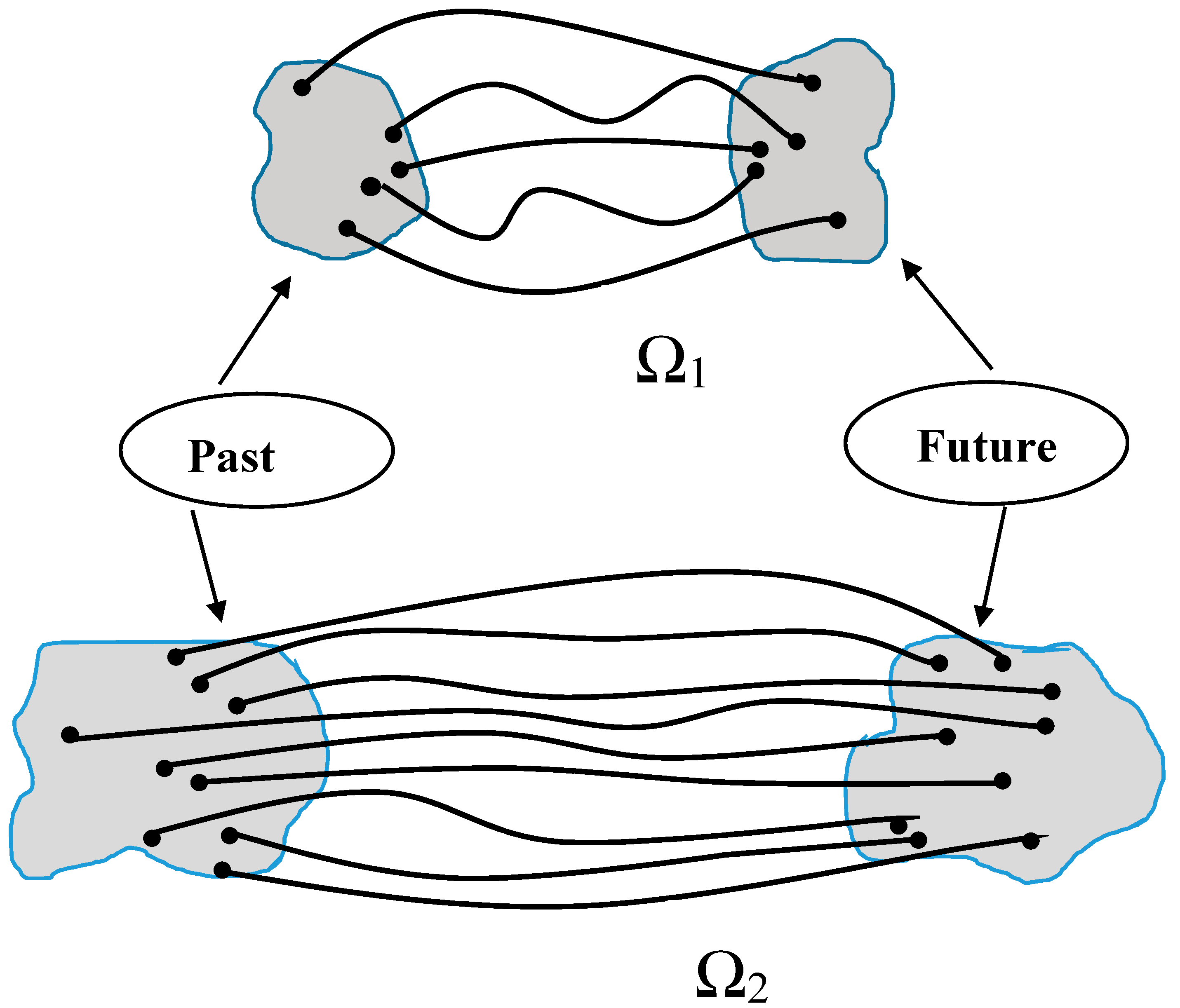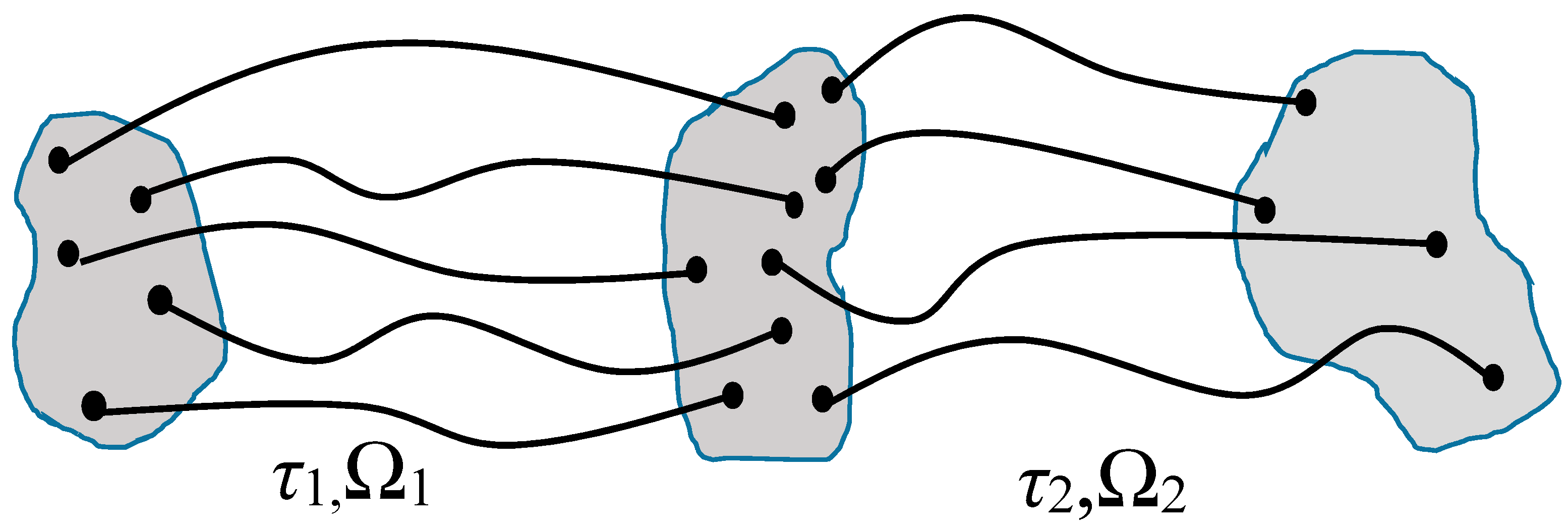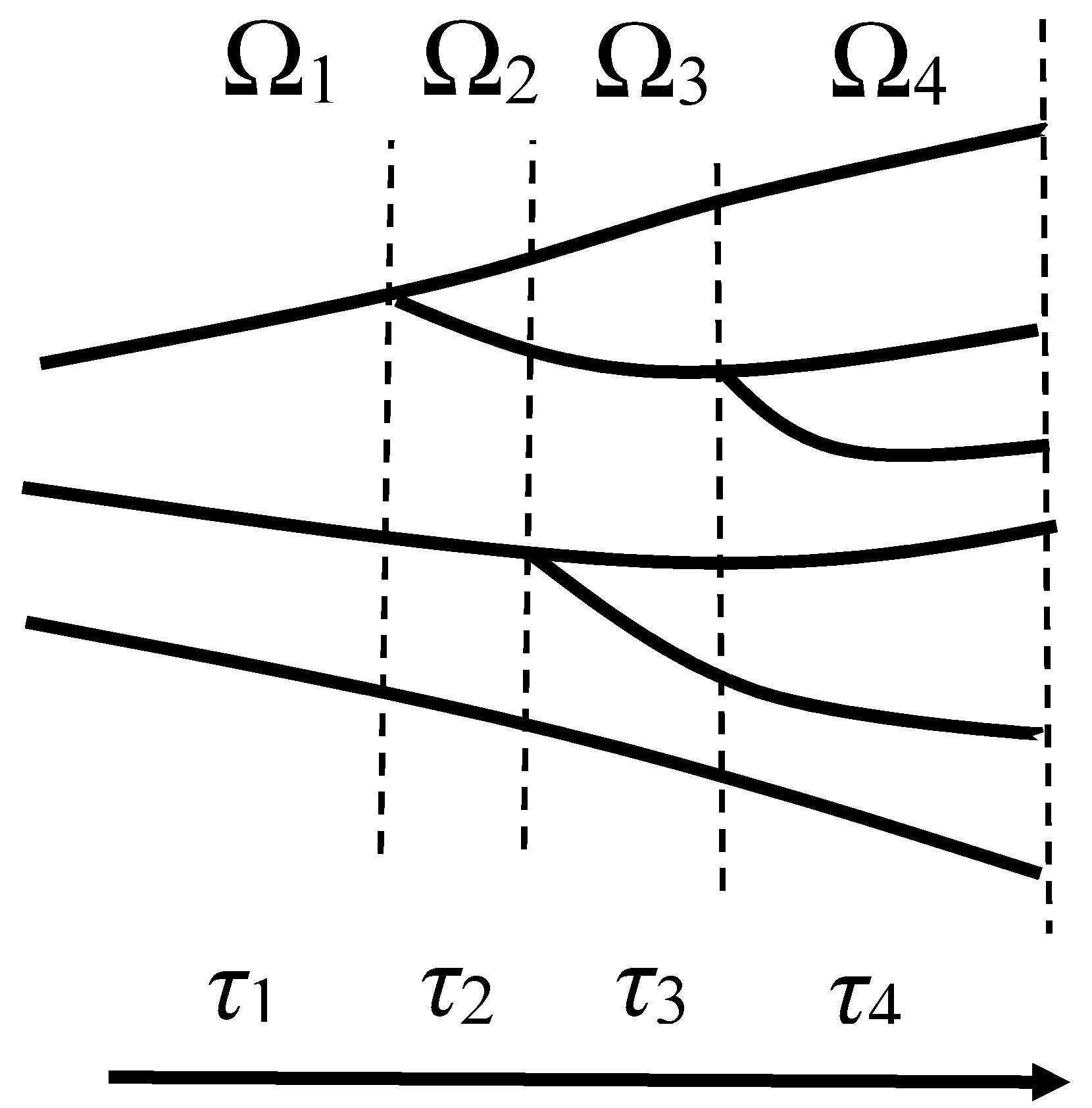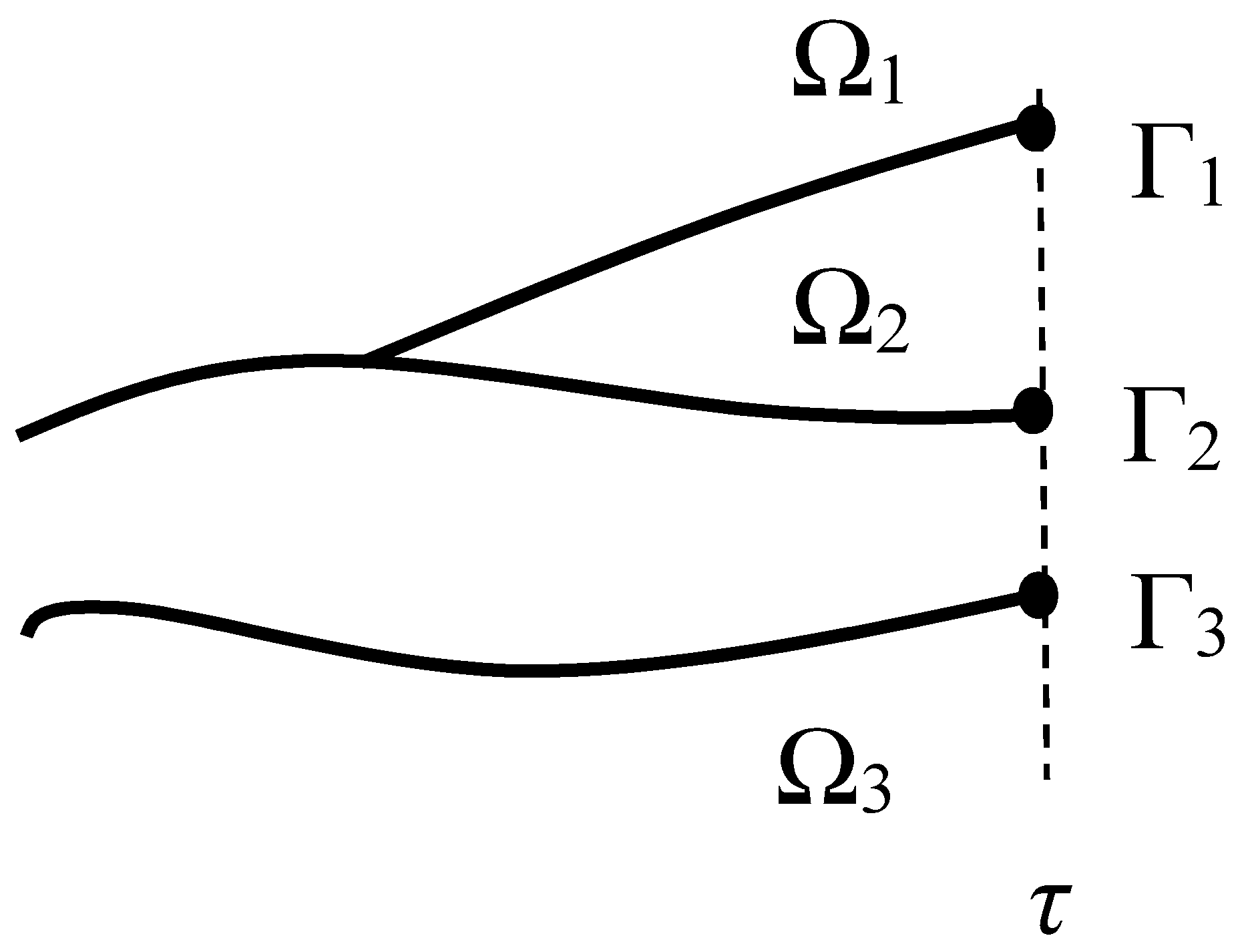On Interrelation of Time and Entropy
Abstract
:1. Introduction
2. A Measure of Time and Its Prerequisites
3. Time and Entropy
4. Discussion
- Measurability and Universality: The introduced measure of time does not require certain periodical or non-equilibrium processes for consideration, local equilibrium, and the like. Instead, it is necessary to have an arbitrary change and an observer who judges about time based on the number of possible ways of describing this change (its duration). Here, this number can be either indirectly measured (E-method) or theoretically calculated (T-method) by finding entropy at any specific level of the consideration of a system. As a result, time is introduced using the method enabling determination for a very wide range of problems in various branches of science. It is important that the time defined here from rather general perspectives is consistent with a number of other papers addressing a similar problem. Let us give three examples. (1) The expression of a process’s time through thermodynamic entropy can be found in a number of physical studies (see, for example, [2,12,13,14]). The following quotation of E. Mach demonstrates this very clearly (quoting from [14], p. 145: “If the entropy of the world could be determined, it would be an absolute measure of time and it would be, at best, nothing but a tautology to say that the entropy of the world increases with time. Time, and the fact that certain changes take place in a definite sense, are one and the same thing”. (2) In biology, time (biological time) related to the metabolic rate and entropy production during life activities (see [3] and its references) is used to consider the time of living and growth of living beings. (3) In psychology, the perception of the duration of time is associated with an amount of energy consumed by neurons (and with other metabolic processes in the brain) as well as the intensity of cognitive processes and the amount of information stored in the memory [15,16]. The mentioned examples can be regarded as an independent evidence corroborating the ideas developed herein.
- Time is Relative and Subjective: Indeed, this quantity is often considered in physics as something absolute and objective, independent of anything else. Einstein’s relativity theory has shaken confidence in these ideas only to some extent. We base our reasoning here totally independently of the mentioned traditional ideas. This is connected with the fact that time, while reflecting objective changes in the world, is inseparable from an observer. The observer cannot be abstract (metaphysical). Basic properties of the observer can be presently connected only with characteristics of the human brain, which has been evolving together with the world. Hence, the relativity and subjectivity of time. At the same time, it is the brain that ‘strives’ to reflect changes in the surrounding world with minimum distortions. This is what prevents us from drawing a conclusion that the human is unable to formulate laws describing and predicting changes in the world. The ‘sense of time’ arises because the human represents a part of the evolving world where everything interacts directly or indirectly to a certain extent. This sense (understanding of time) is gradually adjusted in the course of evolution through individual and collective experience (including, for instance, by science). As a result of such an adjustment (synchronization), the brain’s understanding of changes in the world using time (for instance, with the help of the T-model) allows reflecting the real surrounding world. Synchronization of an observer and a process (as well as synchronization of different processes with each other) suggests that the time introduced herein as an individual characteristic of every evolving process can describe, in some cases, a number of interacted processes, i.e., be a system characteristic.
- Directionality of Time (Arrow of Time): The introduced time is directional by its definition. The farther the past and future horizons of some change, the more the possible ways of connecting these horizons and, consequently, the longer the time. The human brain is the source of these observations and predictions; as was mentioned above, it represents an open, ever-changing (among other things, due to memory-related processes) and adaptive system. These properties of the brain prevent any reversibility from occurring in the results of its work. The described interrelation of time and entropy also indicates the irreversibility of time. However, there is a widely-spread opinion well expressed in the book [17]: “It’s very possible that this mysterious irreversibility is of precisely the same character as the mysterious irreversibility in thermodynamics, as codified in the Second Law: It’s a consequence of making approximations and throwing away information, even though the deep underlying processes are all individually reversible”. The opinion defended herein is totally opposite to this statement: nature is in principle irreversible, while equations (laws) traditionally considered as ‘fundamental’ are approximate, which is the only reason of their reversibility. The case is that the fundamentality of a law of nature is as historically anachronistic as the absoluteness of space and time. It is well known from the times of K. Popper that any absoluteness and firmness presuppose unscientific (pseudoscientific) laws (theories) rather than scientific ones. Indeed, any scientific theory represents a continuous chain of improvements, conjectures, and refutations. Examples from mechanics are the most well-known: the Kepler laws were replaced with the Newton laws that were replaced with the laws of quantum mechanics and the relativity theory. Yes, all of the above are the examples of reversible equations. However, it does not prove the reversibility of the world. These equations are only brilliant guesses that described some changes in nature within the accuracy required for their times. These laws are not divinely conferred or, at least, rigorously obtained from the standpoint of mathematics. These laws are fruits of our brain that observed the surrounding world and, under the influence of a number of purely “human” qualities such as the principles of simplicity, beauty, correspondence, and the like, approximately formulated these laws by discarding details and taking the essence. The understanding of time is related to the human; however, any human-related science (biology, psychology, history, archaeology, linguistics, etc.) demonstrates the arrow of time and, therefore, the true nature of time cannot be reversible. For this reason, the majority of time measures used in physics are logically (not practically) invalid because they are based on time-reversible concepts of the modern quantum and electromagnetic theories and, hence, contradict the crucial property of time.
- Non-Uniformity of Time: According to the introduced definition as well as the relation of time and entropy (entropy production) under discussion, time is obviously non-uniform. Although, it absolutely contradicts the understanding of time that has appeared in science thanks to I. Newton, one cannot claim that this statement is original today. For instance, there is a well-known quotation of H. Poincaré [18]: “We have not a direct intuition of the equality of two intervals of time. The persons who believe they possess this intuition are dupes of an illusion. When I say, from noon to one the same time passes as from two to three, what meaning has this affirmation? The least reflection shows that by itself it has none at all. It will only have that which I choose to give it, by a definition which will certainly possess a certain degree of arbitrariness”. It is important to note that the understanding of time being non-uniform (non-linearly connected with the “time” hypothetically considered uniform) turns out to be a crucial, necessary, and commonly-accepted provision for a very wide range of problems solved by theoretical biology and psychology, specifically when addressing the issues of ontogenesis and development (see, for example, [3]). Non-uniform time scales are also sometimes used in physics. This is especially true for cosmological questions. There are well-known, now classical, works by E. Milne [1,19], where he obtains two logarithmically-interrelated measures of time while building his cosmology. Nowadays, these works of the last mid-century have become especially topical in connection with the dark energy problem. A number of contemporary cosmologists involve the idea of non-uniformity of time by either developing the ideas of Milne or arriving at them independently [20,21,22,23,24].
5. Conclusions and Prospects
Acknowledgments
Conflicts of Interest
References
- Milne, E.A. Kinematic Relativity; Clarendon Press: Oxford, UK, 1948. [Google Scholar]
- Martyushev, L.M.; Shaiapin, E.V. Entropic measure of time, and gas expansion in vacuum. Entropy 2016, 18, 233. [Google Scholar] [CrossRef]
- Martyushev, L.M.; Terentiev, P.S. A universal model of ontogenetic growth. Sci. Nat. 2015, 102. [Google Scholar] [CrossRef] [PubMed]
- Rose, S. The Making of Memory: From Molecules to Mind; Bantam: London, UK, 1992. [Google Scholar]
- Yaglom, A.M.; Yaglom, I.M. Probability and Information; Hindustan Publishing Corporation Press: New Delhi, India, 1983. [Google Scholar]
- Brillouin, L. Science and Information Theory; Dover Publications: Mineola, NY, USA, 1956. [Google Scholar]
- Landau, L.; Lifshitz, E. Statistical Physics; Butterworth-Heinemann: Oxford, UK, 1980. [Google Scholar]
- Ziegler, H. An Introduction to Thermomechanics; Elsevier: Amsterdam, The Netherlands, 1983. [Google Scholar]
- Martyushev, L.M.; Seleznev, V.D. Maximum entropy production principle in physics, chemistry and biology. Phys. Rep. 2006, 426, 1–45. [Google Scholar] [CrossRef]
- Martyushev, L.M. Entropy and entropy production: Old misconceptions and new breakthroughs. Entropy 2013, 15, 1152–1170. [Google Scholar] [CrossRef]
- Martyushev, L.M.; Zubarev, S.N. Entropy production of main-sequence stars. Entropy 2015, 17, 658–668. [Google Scholar] [CrossRef]
- Whitrow, G. The Natural Philosophy of Time; Oxford University Press: Oxford, UK, 1960. [Google Scholar]
- Reichenbach, H. The Direction of Time; University of California Press: Oakland, CA, USA, 1991. [Google Scholar]
- Kragh, H.S. Entropic Creation. Religious Contexts of Thermodynamics and Cosmology; Ashgate Publishing: Farnham, UK, 2008. [Google Scholar]
- Schiffman, H.R. Sensation and Perception. An Integrated approach; John Wiley&Sons: New York, NY, USA, 2001. [Google Scholar]
- Hammond, C. Time Wrapped. Unlocking the Mysteries of Time Perception; Harper Perennial: New York, NY, USA, 2012. [Google Scholar]
- Carroll, S. From Eternity to Here. The Quest for the Ultimate Theory of Time; Dutton: New York, NY, USA, 2010. [Google Scholar]
- Poincaré, H. La Mesure Du Temps. Rev. Métaphys. Morale 1898, 6, 1–13. (In French) [Google Scholar]
- Milne, E.A. Modern Cosmology and the Christian Idea of God; Clarendon Press: Oxford, UK, 1952. [Google Scholar]
- Vishwakarma, R.G. A Curious Explanation of Some Cosmological Phenomena. Phys. Scr. 2013, 87, 055901. [Google Scholar] [CrossRef]
- Vishwakarma, R.G. Mysteries of Rik = 0: A Novel Paradigm in Einstein’s Theory of Gravitation. Front. Phys. 2014, 9, 98–112. [Google Scholar] [CrossRef]
- Magain, P.; Hauret, C. Variable Time Flow as an Alternative to Dark Energy. arXiv, 2016; arXiv:1606.06169. [Google Scholar]
- Taganov, I.N. Irreversible-Time Physics; TIN: Saint Petersburg, Russia, 2013. [Google Scholar]
- Chaisson, E.J. Energy Flows in Low-Entropy Complex Systems. Entropy 2015, 17, 8007–8018. [Google Scholar] [CrossRef]




© 2017 by the author. Licensee MDPI, Basel, Switzerland. This article is an open access article distributed under the terms and conditions of the Creative Commons Attribution (CC BY) license (http://creativecommons.org/licenses/by/4.0/).
Share and Cite
Martyushev, L.M. On Interrelation of Time and Entropy. Entropy 2017, 19, 345. https://doi.org/10.3390/e19070345
Martyushev LM. On Interrelation of Time and Entropy. Entropy. 2017; 19(7):345. https://doi.org/10.3390/e19070345
Chicago/Turabian StyleMartyushev, Leonid M. 2017. "On Interrelation of Time and Entropy" Entropy 19, no. 7: 345. https://doi.org/10.3390/e19070345




